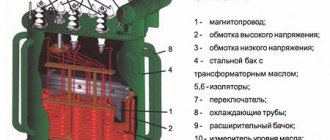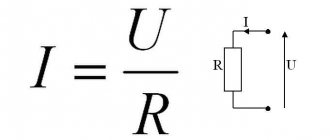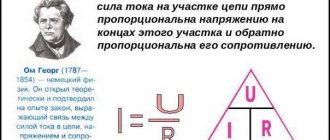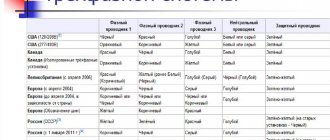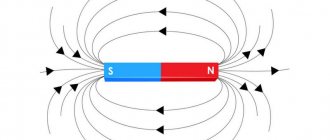When choosing an educational institution for training in electrician courses, you need to pay attention to several important points. First of all, this is the teaching staff. Teachers must be qualified specialists with sufficient knowledge and experience. Also, the training center must have specially equipped classrooms for theoretical and practical classes, since without proper logistics, training is impossible.
Training should be divided into theoretical study of the fundamentals of the electrician profession and deep practical application of the acquired knowledge. Below is a selection of training centers where you can take electrician courses in Moscow.
Training Center (CAO)
Address : metro station Park-Kultury, Khilkov lane, 2, building 5 Website : https://www.diofort.ru Telephone Cost : 12350 rub. per course
Experienced teachers of the center will help you master all the necessary and important concepts, show you in practice how to properly work with cable power lines, carry out electrical repairs and much more.
Course duration: 40 ac. h.
Lesson mode:
- standard;
- intensive.
Course curriculum:
- Introduction to electrical engineering course.
- Electricity of the net.
- Consumer transformer substations.
- Design and installation of electrical wiring.
- Wires and cables, technical requirements for electrical wires.
- Internal electrical wiring.
- Open electrical wiring with twisted single-core wires PRD, PRVD, APV, PV, APRI, PR.
- Open electrical wiring with flat wires APPV, PPV on rollers.
- Hidden electrical wiring with flat stranded wires.
- Technology for laying electrical wiring in steel and plastic pipes.
- Connection and termination of wires (copper and aluminum).
- Installation of switches and sockets.
- Installation of lamps.
- Electrical wiring in basements and attics.
- Installation of apartment panels (tools, fixtures, devices).
- Power lines (overhead, wires for overhead lines, supports and insulators).
- Branches from overhead lines to building inputs.
- Cable power lines.
- Organization of electrical network maintenance.
- Typical faults of electrical equipment and ways to eliminate them.
- Electrical installation devices.
- Lamps and incandescent lamps.
- Lamps with fluorescent lamps.
- Connecting cords and plugs.
- Apartment shields.
- Preventive testing of electrical wiring.
- Use and connection of electric pumps for water supply.
- Use of electrical energy for thermal purposes.
- Electrified tools and machines for repair and construction work.
- Safety regulations.
Safety and Practice
First you need to carefully study the section regarding safety precautions. In this case, during work related to electricity, there will be no emergency situations hazardous to health.
In order to put into practice the theoretical knowledge gained after self-studying the basics of electrical engineering, you can start with old household appliances. Before starting repairs, be sure to read the instructions included with the device. Don't forget that you shouldn't joke with electricity.
Electric current is associated with the movement of electrons in conductors. If a substance is not capable of conducting current, it is called a dielectric (insulator).
For free electrons to move from one pole to another, there must be a certain potential difference between them.
The intensity of the current passing through a conductor is related to the number of electrons passing through the cross section of the conductor.
The speed of current flow is affected by the material, length, and cross-sectional area of the conductor. As the length of the wire increases, its resistance increases.
College of Science and Technology (CAO)
Address : metro station Smolenskaya, Novinsky Boulevard, 8 Website : https://www.collegent.ru Phone Cost : 12900 rub. per course
The College of Science and Technology has all the conditions for successful study:
- classrooms with modern equipment;
- practicing teachers with extensive professional and pedagogical experience;
- Individually focused practical classes in small groups of up to 6 people.
Upon completion of their studies, graduates are awarded a standard certificate, and the college provides assistance in finding employment.
Duration of training is 1 month.
Variable and constant quantities
When electricity was just in its infancy, consumers were supplied with direct current. However, it turned out that the standard value of 220 volts is almost impossible to transmit over a long distance.
On the other hand, you cannot supply thousands of volts - firstly, it is dangerous, and secondly, it is difficult and expensive to manufacture devices operating at such a high voltage. As a result, it was decided to convert the voltage - 10 volts reaches the city, and 220 volts reaches the houses. The conversion takes place using a transformer .
As for the voltage frequency, it is 50 Hertz. This means that the voltage changes its state 50 times per minute. It starts from zero and rises to 310 volts, then drops to zero, then to -310 volts and rises to zero again. All work proceeds in a cyclical manner. In such cases, the voltage in the network is 220 volts - why not 310 will be discussed later. Abroad there are different parameters - 220, 127 and 110 volts, and the frequency can be 60 hertz.
Educational (Southern Administrative District)
Address : metro station Serpukhovskaya, 3rd Pavlovsky lane, 1, bldg. 57, p. 3 Website : https://kursy-rabota.ru Phone Cost : 14900 rub. per course
At the beginning, a theoretical course is conducted two to three times a week for 4 lessons. hours at the training center. Groups usually have 6-8 people. Then options for a two-week internship are selected for you. It is possible to choose an internship in different areas of the city.
The electrician course program includes the following sections:
- Occupational health and safety.
- General information about electrical materials.
- Electrical wiring (external and internal).
- Electrical equipment.
- Installation of lighting networks.
- Electrical installation products and tools.
- Grounding.
- Installation of power networks, etc.
Course duration: 2 months. (50 academic hours, practice 8 hours + 15 hours welding + 1 month industrial practice).
Class schedule: 2-3 times a week for 4 lessons. hours a day.
After completing the courses, a standard certificate is issued with the assignment of 3rd category.
Who needs our course?
- For electricians
...to workers in the housing and communal services sector who service electrical installations of industrial and commercial facilities.
To work efficiently and earn decent money!
- For builders
...moonlighting by installing lamps, replacing sockets and minor wiring repairs.
So as not to be afraid to lose face and become better than many electricians!
- Foreman
...for those who want to thoroughly know the ins and outs of electrical installation work and finally shake off the noodles spread by cunning subordinates from their ears!
- Auto electricians
…especially for installers of security systems and additional (non-standard) electrical equipment.
So as not to redo the work under warranty!
Perhaps someone reading these lines saw a contradiction between the title and subtitle of the course (“Basic electrician skills.” Online advanced training course)…
How is it that the course is basic (as if for beginners), but the subtitle talks about advanced training (as if for experienced electricians)?! Do they teach here from scratch or work with experienced specialists? Maybe there was a typo?
Alas, there is no typo.
We often confuse (confuse) work experience and level of qualifications. According to this primitive logic, the more time a specialist is listed as an electrician, the higher his professionalism. But in reality this is not true at all! Wisdom does not come to everyone with age; age comes to many alone.
Some “electricians, as it were,” having learned to change light bulbs in their youth, continue to do this until their retirement. When they are asked to take on more complex tasks, they either take the pose of “we didn’t go through this, we weren’t asked to do this,” or they do the job so poorly that they discourage any desire to contact them in the future.
Of course, the example with replacing lamps is somewhat exaggerated (and “as if electricians” usually don’t read this far), but we hope you get the gist. Having so-called experience does not guarantee that the electrician’s professional skills are all right. We have already cited sad statistics that clearly show that most modern electricians do not know how to work with their hands. What can I say... Many of our colleagues experience on a daily basis how a lack of confident skills prevents them from working normally and earning a decent living!
Relearning is always more difficult than learning correctly right away. The temptation is great to put off a difficult task until later! However, with age, the inertia of the human psyche deepens, and breaking out of the vicious circle requires more and more effort. Therefore, we highly recommend enrolling in the Basic Electrician Skills course now and making the most of the learning experience.
City Vocational Training Center (South Administrative Okrug)
Address : metro station Serpukhovskaya, Party Lane, 1 to 57 st. 3 Website : https://profrab.com Telephone Cost : 22900 rub. per course
Electrician courses involve the creation of small groups in which no more than 4 people will be trained. This will allow the teacher to pay maximum attention to each student, correctly place emphasis on the features of the profession, and control the level of material learned.
Highly qualified teaching staff, an effective express training program, and the opportunity to gain practical skills are the main advantages of courses at the city vocational training center.
Profile groups are formed weekly. You can choose the most preferred time of classes, which start at 10.00, 13.00 and 17.00. Duration 3-4 hours a day. Thus, you can study in a morning or evening group, as well as on weekend courses.
In 3 weeks of training you will be able to learn:
- about the features of installation of power and lighting networks;
- installation of electrical equipment;
- laying external and internal electrical wiring.
Get general information about:
- materials;
- electrical installation products;
- details for them.
Explore:
- basic electrical installation tools;
- mechanisms;
- equipment designed to assist in the work of an electrician.
Learn skills that will allow you to:
- cut live cables;
- roll out wires;
- install drums.
You will learn:
- install grounding devices;
- dismantle apparatus and devices;
- install lighting boxes for wires or cables. At the end of the course, you will be assigned a rank corresponding to the acquired knowledge and skills (3rd or 4th rank), and you will also receive a standard certificate.
Features of electrical engineering
The textbook “Electricity for Dummies” is popular among those who are far from physics, but plan to use this science for practical purposes.
The date of appearance of electrical engineering is considered to be the beginning of the nineteenth century. It was at this time that the first current source was created. The discoveries made in the field of magnetism and electricity managed to enrich science with new concepts and facts of important practical significance.
The “School for Electrician” manual assumes familiarity with the basic terms related to electricity.
PromProfAlliance (VAO)
Address : metro station Shchelkovskaya, Shchelkovskoe highway no. 100 building 1 office 3004 Website : https://docsro.ru Telephone Cost : from 3700 rub. per course
The center offers students electrician courses followed by obtaining a standard certificate.
What the courses will teach:
- Theory and practice of working with electrical appliances and the electrical network.
- Fundamentals of electromechanics, electrical communications.
- Study of electric generators, transformers, electric motors.
- Design of wiring diagrams in an apartment, house, or on a site.
- Collection/repair of electrical networks of varying complexity.
- Cable installation, connection to the general network.
Training is carried out on the basis of vocational and secondary education. Programs are also taken to obtain a higher rank or change specialization. Distance classes are possible.
BASIC SKILLS FOR ELECTRICIAN
ONLINE ADVANCED PROFESSIONAL COURSE
Hello, dear colleague!
How are you doing? Are you doing well at work? Do you have enough money? Is your work respected in society?
In response to these pressing questions, of course, you can laugh it off - they say, there is never too much money, all customers are assholes, and society has no time for the work of an electrician, it is looking for spiritual bonds...
However, streamlined answers do not lead to solutions to objectively existing problems.
If you dig deeper, you will certainly find that we create most of the difficulties for ourselves.
Not wanting to realize and accept responsibility for our own lives and professional activities, many of us are not particularly eager to develop, improve our skills, or improve our qualifications. Not everyone had the opportunity to study systematically - the bulk of today's specialists came to electrical engineering by accident, “by the will of the waves,” and the quality of traditional technical education has dropped sharply in recent years.
It is impossible to build a large and beautiful house on a flimsy foundation! The lack of confident basic skills greatly hinders the professional growth of an electrician and provokes a number of negative phenomena.
- Toxic relationship
Nobody respects insecure professionals with trembling hands and fidgety movements.
This is how toxic relationships with customers/employers and a low income ceiling are formed.
- Waste of time
A weak level of proficiency in basic electrician skills leads to unnecessary waste of time.
The work takes an unacceptably long time to complete and often has to be redone under warranty.
- Extreme poverty
The chronic lack of decent earnings gives rise to a lot of everyday problems and threatens debt traps.
It is easy to fall off the social ladder, but it is incredibly difficult to climb it.
- Stagnation in everything
The meager wages (services) of an electrician lead to a shortage of resources for development. Long-term stagnation pushes you into a vicious circle: no strong skills, no money, and nothing to learn.
The problem described above is widespread. Our professional community is inert, and its participants are realizing the need for change very slowly. For now, things are still going strong, and weak performers contribute to the formation of negative ideas in society about the activities of an electrician. The facts speak for themselves...
Trade union center (SVAO)
Address : metro Botanical Garden, st. Selskhozyaystvennaya 17, bldg. 4 Website : https://prodpo.ru Phone Cost : from 4900 rub. per course
Based on the results of training, electricians are issued a certificate of the established form for a period of 1 year with the signature of a representative of Rostechnadzor and a “Logbook for recording and testing knowledge of the rules of work in electrical installations” with the signature of a representative of Rostechnadzor.
The training program lasts 72 hours.
Types of profession
The specialty of an electrician provides a fairly wide range of responsibilities and work performed in a wide variety of industries.
Among these areas it is worth highlighting:
- Electricians - install electrical wiring and other electrical equipment in both low-voltage and high-voltage networks.
Installation work
- Operating personnel - monitors the condition and operating modes of electrical equipment, interacts between various electrical installations and even parts of the power system.
- Electricians who set up and test equipment before commissioning and during power supply.
Equipment setup
- Electronic engineers - work with electronic circuits, including modern equipment (computers, servers, etc.), and solder radio components.
Working with electronic circuits
- Auditors - analyze energy consumption and consumption, develop effective measures to reduce losses, etc.
This list defines only the main areas; in practice, there are applications depending on the relevant industry: auto electricians, network engineers, substation workers, railway electricians, electricians servicing automation and telemechanics systems, relay protection systems, specializing in household networks, etc.
Network maintenance
For each specific production or job, the responsibilities of an electrician and the amount of knowledge required of him are determined by local instructions and regulations.
Educational (NEAD)
Address : metro Botanical Garden, st. Selskhozyaystvennaya, 17, bldg. 4 Website : https://vi-pro.ru Phone Cost : from 8000 rub. per course
The training center provides training within the framework of programs that comply with regulatory requirements and approved by Rostechnadzor.
The programs, developed by experienced specialists, are intended for both experienced specialists and inexperienced students wishing to obtain an electrician specialty and permission to carry out the relevant work.
During the training, the following topics in this profession are studied:
- Reading and modification of electrical diagrams.
- Carrying out electrical measurements and calculations.
- Installation of sockets, switches, electricity meters.
- Installation of lighting electrical wiring and equipment.
- Installation of grounding devices, protective and control equipment.
- Disassembly, repair, assembly of parts and assemblies of electrical equipment.
- Installation of electrical machines and transformers.
The courses involve theoretical and practical classes in the workshops of the training center. Each student carries out a series of independent works on working with electrical equipment and finding faults in electrical wiring. Training to become an electrician ends with passing a qualifying exam.
Those who successfully pass the exam are issued a certificate with the qualification of an electrician and the assignment of qualification category 2-3.
Express course:
- daytime (2 times a week);
- 10:00 – 16:00 (6 school hours);
- 2.5 weeks training.
Standard course:
- daily (daily);
- 10:00 – 16:00 (6 school hours);
- 2.5 weeks training.
Tips for beginners
Many physics books contain complex electrical diagrams and a variety of confusing terms. In order for beginners to understand all the intricacies of this section of physics, a special manual “Electricity for Dummies” was developed. An excursion into the world of the electron must begin with a consideration of theoretical laws and concepts. Illustrative examples and historical facts used in the book “Electricity for Dummies” will help novice electricians acquire knowledge. To check your progress, you can use assignments, tests, and exercises related to electricity.
If you understand that you do not have enough theoretical knowledge to independently cope with connecting electrical wiring, refer to reference books for “dummies”.
City Center for Continuing Professional Education (CAO)
Address : metro station Belorusskaya, 3rd street Yamskogo Pole, building 2, building 13, 6th floor Website : https://doprof.ru Telephone Cost : 13150 rub. per course
The main objective of this training course is the professional training of students and their preparation for practical work, high-quality installation and maintenance of electrical networks.
The training center regularly recruits students for this training course in groups of morning, afternoon and evening training. The center can also offer you weekend and intensive training groups.
Students who have completed training as electricians in this course receive a document of completion: a certificate of the established form.
The training center also provides assistance and assistance to its graduates in further employment.
Course curriculum:
- Topic 1: Basics of electrical engineering.
- Topic 2: Wires and cables.
- Topic 3: Electrical networks of civil buildings and utilities.
- Topic 4: Input and input-distribution devices.
- Topic 5: Electrical wiring.
- Topic 6: Electric lighting.
- Topic 7: Electrical safety. Questions and answers.
- Topic 8: Measures to ensure safety of work in electrical installations.
- Topic 9: The effect of electric current on a person, rules for providing first aid to a victim of electric current.
Number of academic hours: 72, classes: 18.
AC transmission circuit
Let's try to understand what a phase is in electricity. Everyone has heard this word, but not everyone understands its true meaning. We will not go into details and details; we will select only the material that the home craftsman needs. A three-phase network is a method of transmitting electric current, in which current flows through three different wires, and one returns it. For example, there are two wires in an electrical circuit.
Current flows through the first wire to the consumer, for example, to a kettle. The second wire is used to return it. When such a circuit is opened, there will be no passage of electric charge inside the conductor. This diagram describes a single-phase circuit. What is a phase in electricity? A phase is considered to be a wire through which electric current flows. Zero is the wire through which the return is carried out. In a three-phase circuit there are three phase wires at once.
An electrical panel in an apartment is necessary to distribute electric current throughout all rooms. Three-phase networks are considered economically feasible because they do not require two neutral wires. When approaching the consumer, the current is divided into three phases, each with a zero. The ground electrode, which is used in a single-phase network, does not carry a working load. He is a fuse.
For example, if a short circuit occurs, there is a threat of electric shock or fire. To prevent such a situation, the current value should not exceed a safe level; the excess goes into the ground.
The manual “School for Electricians” will help novice craftsmen cope with some breakdowns of household appliances. For example, if there are problems with the functioning of the electric motor of the washing machine, current will flow to the outer metal casing.
If there is no grounding, the charge will be distributed throughout the machine. When you touch it with your hands, a person will act as a grounding conductor and receive an electric shock. If there is a ground wire, this situation will not arise.
School of training for masters "Fixit" (SAO)
Address : metro station Aeroport, Leningradsky Prospekt 47 building 2 Website : https://fixit-plus.ru Telephone Cost : 8000 rub. per course
Training time is 2 weeks. It is possible to undergo training to become an electrician in a shortened period of time, in one week, and you will need to study from morning to evening. Upon completion of studies, the student is issued a certificate giving the right to employment on the same basis as a diploma from a school or college (specialized secondary education).
Training program:
- Safety precautions when working with electricity.
- Measuring instruments and necessary tools.
- Connecting electrical wiring, installation according to the diagram, drawing up diagrams yourself.
- Troubleshooting in electrical circuits.
- Soldering, working with soldering equipment.
- We read the diagrams.
- Independent production of electrical appliances according to diagrams.
Who is to blame and what to do?
As already mentioned, the sphere of vocational education in the Russian Federation and in most of the post-Soviet space today ekes out a miserable existence. Young people who do not want to wipe their pants in the office may have nowhere to go to study.
Even if you manage to find more or less decent electrician courses, it turns out that the educational process there is overloaded with theory, and minimal attention is paid to the formation of skills. In the few vocational schools (colleges), students are often required to do internships on their own - they say, find some operating enterprise and learn the real business there...
Obviously, with such an approach it is extremely difficult to learn anything worthwhile. Therefore, we have what we have...
From time to time, voices are heard claiming that nothing terrible is happening (everything is going according to plan) - they say, as long as there is oil and gas, it is not necessary to work hard, let the workers and engineering professions be mastered by guest workers. However, we recall that work turned a monkey into a man, and a categorical refusal to work quickly starts the reverse process.
There is a “benign” genocide of the indigenous peoples of the Russian Federation, and the degrading population is gradually being replaced by migrants. However, reasoning cannot correct the situation. As you know, saving drowning people is the work of the drowning people themselves.
Start with yourself. While there is still time and other resources, do not bring the situation to complete and final stagnation. Learn, improve, work, earn! Get involved in business in the field of electrical services!
Those who are familiar with our online projects know that we are fighting to raise the prestige of the electrician profession and qualitatively increase the profits of small electrical businesses and micro-businesses. All enterprising electricians who work for hire are engaged to one degree or another in microbusiness (self-employment or private practice) in their free time from their main job. It is very difficult to live with dignity on one salary in the conditions of constantly increasing prices and quasi-state extortions, so you have to spin.
Thus, all our more or less active colleagues are interested in improving their financial situation, reducing costs, improving the quality of services and improving relationships with customers.
It's possible!
Here are a few theses that reveal the essence of the path we propose.
- Skills
First we work on skills, and then the skills work for us. We encourage you to work hard today for a brighter tomorrow. The future is worth taking care of in advance.
- Quality
Thanks to well-honed skills, things get going. It’s good for us and it’s good for our customers. You know - they want high quality, but are absolutely not ready to wait. Don't argue with customers - be smarter.
- Money
Customers love it when results are achieved easily and beautifully. They are willing to pay exactly for this. We know that training is hidden behind external beauty and ease, but we don’t talk about it out loud. Money loves silence.
- Prestige
The word “electrician” should sound proud! It is necessary to work for prestige so that prestige begins to work for us. Solving this important task begins with the formation of basic professional skills.
The path to our ambitious goal, no matter how much we want, cannot be called easy. There are many obstacles and destructive mental attitudes that need to be overcome. It is no coincidence that the classic said that devastation is not in the closets, but in the heads.
It is pleasant and convenient for people to believe that they are better than they actually are. This pattern manifests itself in almost all spheres of life, and in the activities of an electrician too (hence the inertia and reluctance to change).
Let's honestly answer the question - can a person who has mediocre professional qualities and is absolutely not ready to improve, apply for better conditions?
No, of course he can claim it, but who will give it to him?
Quality work is always done beautifully!
Professional training center "Builder's School" (SZAO)
Address : m. Myakinino, st. Volokolamskoye Highway, 146 Website : https://uslugisro.ru Phone : 8 800 555 2973 Cost : from 4000 rub. per course
The educational institution offers training and retraining courses for electricians of the 3rd, 4th and 5th categories on the basis of our training center, followed by certification and obtaining an electrician’s certificate with permission to work.
Two forms of training are offered:
- full-time (at a training center);
- remote (for those specialists who already have knowledge, experience and qualifications, and only need to prepare for certification and obtain an electrician’s license with permission).
Advantages:
- Many years of successful work experience, competent teachers and experts.
- The training program is compiled individually taking into account the needs of the client.
- Convenient way to receive a document. For residents of Moscow - free courier delivery, for residents of other regions - postal service with cash on delivery.
- We issue an official document of state standard with the seals of our company and the signature of the chairman of the certification commission.
- Optimal combination of price and quality.
Features of the term
Electricity is the energy of small charged particles moving in conductors in a specific direction.
With constant current, there is no change in its magnitude, as well as in the direction of movement over a certain period of time. If a galvanic cell (battery) is chosen as the current source, then the charge moves in an orderly manner: from the negative pole to the positive end. The process continues until it completely disappears.
Alternating current periodically changes magnitude as well as direction of movement.
Power and other parameters
Electrical current is needed to do some work, such as turning a motor or heating batteries. You can calculate how much work it will do by multiplying the current by the voltage. For example, an electric heater with 220 volts and a power of 2.2 kW will consume a current of 10 A.
The standard measurement of power is in watts (W). An electric current of 1 ampere with a voltage of 1 volt can produce 1 watt of power.
The above formula is used for both types of current. However, calculating the first one has some complexity - it is necessary to multiply the current strength by U in each unit of time. And if you take into account that the voltage and strength of alternating current change all the time, then you will have to take the integral. of effective value was applied .
Roughly speaking, the effective parameter is the average value of current and voltage, selected in a special way.
Alternating and direct current has an amplitude and effective state. The amplitude parameter is the maximum unit to which the voltage can rise. For an alternating type, the amplitude number is equal to the effective number multiplied by √ 2. This explains the voltage indicators of 310 and 220 V.

